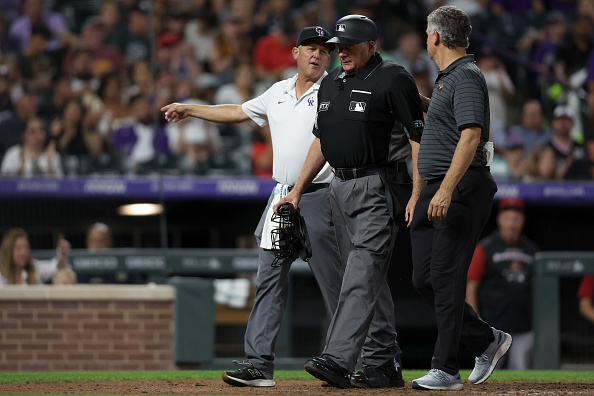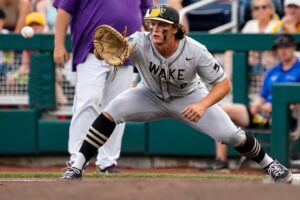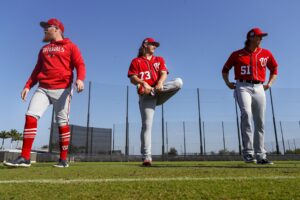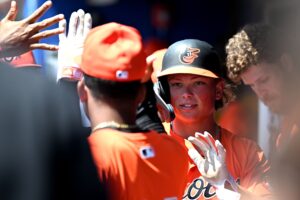Hazards of the Job: Umpire Injury to Jerry Layne as Told by Those Who Witnessed It
It was the bottom of the sixth inning at Coors Field in Denver on July 2. The Colorado Rockies led the Arizona Diamondbacks, 7–5. Diamondbacks right-hander J.B. Wendelken settled in to pitch to Rockies center fielder Randal Grichuk. On 0–1, Wendelken threw a fastball. It tailed in toward Grichuk’s hands. What happened next shows hazards of the job of both catchers and plate umpires. In rapid succession, the ball glanced off the knob and Grichuk’s hand, hit catcher Carson Kelly on the left bicep, caught the outside of the right ear extension on the mask of plate umpire Jerry Layne, and went back to the screen.
Wendelken: “Grichuk backed up, but Carson started tumbling.”
Grichuk: “Initially, I thought it just hit me and hit (Carson), because from what I remember, I don’t think Jerry made much of a big deal about it at first. (Carson) was jumping up and down and was hurting.”
Kelly: “I took most of the blow. It hit Jerry a little bit, just a smidge.”
Grichuk: “It looked like it nicked (Jerry’s) facemask, and I got him in a spot that took a little ring to the bell.”
Rockies manager Bud Black: “When that happens, the first thing the catchers do and the umpires do — when they know that either one of them got hit or both got hit — they turn around and check on each other.”
Grichuk took his base as a wincing Kelly took the time he needed to recover. While Kelly shook off the stinger, Wendelken met Layne to get a new baseball.
Wendelken: “He (Layne) spun out and came up to me. His right eye was normal, and he kept wincing at his left. I asked if he was alright, and he said, ‘Yeah, I’m fine.’ He kind of seemed out of it, but not really — still kind of normal. Gave me the ball and turned around to walk back.”
Grichuk: “I ran to first and looked back, and (Layne) looked a little lightheaded, like dizziness. Then he kind of looked like he needed to get out of there.”
Black: “When Jerry hesitated and was extremely still, I think we all knew that something was up. And then he was in a sense sort of frozen.”
Wendelken: “He was setting up like he was good to go, waiting on Carson. At least that’s what it seemed like he was doing, and that’s when things went kind of sideways.”
Replays indicated that the pitch hit the knob of the bat before hitting Grichuk, so the Diamondbacks were going to challenge. However, manager Torey Lovullo wanted to clarify what the call was first. He came out of the dugout to talk to Layne about the decision. During that conversation, Lovullo’s face changed to a look of deep concern.
Black: “Torey came out to check on the play. And then watching Torey, his conversation with Jerry immediately turned from a ruling conversation to, ‘Hey, are you okay?’”
Wendelken: “Torey was talking to (Jerry) and trying to ask him about checking (on the play). (Jerry) seemed like he was a little out of it. That’s when (Torey) asked him if he was alright.”
Kelly: “(Jerry) started talking to Torey, and then started — I don’t know what exactly went on there, but I think he started to feel a little woozy.”
Lovullo: “He wasn’t making a lot of sense to me. When I got there, I asked him what the official play was that he called, and he did not give me a very clear response. So I asked him if he was feeling okay, because it seemed like the ball hit him in the face mask. And he said, ‘To tell you the truth, I don’t remember where the runner is, and my left eye’s a little blurry.’”
Lovullo grabbed a hold of Layne’s arm, bracing him, and beckoned to Dr. Rich Crenshaw, the Diamondbacks team physician.
Black: “(Torey) put his hand on him, and the trainer came out. Jerry was still very still — uncharacteristically still. I saw him sort of talking, mumbling.”
Lovullo: “I felt like he needed a little bit of help, because he wasn’t responding in a very favorable way. So I put my arm around him and signaled for the medical staff to come over. At that point, he kind of leaned into me a little bit, and I felt like he wasn’t very stable. So I told him I’d stay with him until he was okay and the trainers were there, and everything’s gonna be just fine.”
Rockies head trainer Keith Dugger, one of the leading authorities on head injury care in all of Colorado, joined Crenshaw to check on Layne. Soon, the trio left the field. Rockies rehab coordinator Scott Murayama later rode to the hospital with Layne. Layne turned out to be severely dehydrated. There was no concussion, but due to the dehydration, he was woozy enough to have similar symptoms to someone who had been concussed.
Black: “I heard from Scotty, got updated. And then the umpires again at home plate the next day mentioned that Jerry was extremely dehydrated.”
Lovullo: “I know that if you look at the high overhead, the mask moves a little bit. So he got clipped a little bit. And he, combined with the dehydration, the severe dehydration, I could see that it was a big problem.”
Meanwhile, replay overturned the on-field decision of “hit by pitch,” so Grichuk returned to the plate to finish his at-bat. Second base umpire Chad Whitson, the backup plate umpire, hustled to the umpire dressing room to put on his gear. The chief concern, however, was Layne — the league’s longest tenured umpire and someone who, according to several veterans, is well-respected throughout the league.
Lovullo: “Jerry’s a beautiful man. He’s been in this game a long time. I’ve known him as a player as a coach and as a manager, and he always gives an unbelievable effort and I hate to see him in that situation. I wasn’t gonna leave his side until I knew he was okay.”
Black: “I’ve known Jerry for a long time. Jerry and I are — his first year of umpiring was ‘78. My first year as a minor league player was ‘79. We’ve grown up together. So, I was concerned because I’ve known him for a long time. And anytime a veteran umpire gets disoriented, it worries me. Kerwin Danley (who had to retire this past offseason due partly to head injuries) — I went to San Diego State with Kerwin. So you’re concerned, a lot because you know them on a personal level. And they’re a little bit older, and you don’t like to see that. So, again, from afar, I saw the two trainers and then Torey got out of there. And then that conversation with Jerry. I knew that he wasn’t in a good spot.”
Wendelken: “Talking to — I believe it was the first base umpire (Nick Mahrley) — he came up to me (and said), ‘Hey, we’re gonna go change umpires. (We’re) gonna give him a few minutes. He’s gonna change. Get what you need,’ basically. And I (asked), ‘What happened?’ He said, ‘Well, he’s already had a couple of shots in the head, I believe last year, and maybe a few this year.’ So I think it was a worrisome moment for him….”
Wendelken was correct. It was a worrisome moment for Layne. As Mahrley indicated, Layne has a history of head injuries. While working the plate August 18, 2006, the barrel of a broken bat struck him, bruising his jaw. A foul ball struck the top of his head, giving him a concussion, while he was at the dish on June 7, 2008. Another broken bat struck him June 22, 2012, hitting him on the left side of the head, while he called balls and strikes. This game in Denver was the seventh since 2015 that Layne has left after suffering a blow to the head. Naturally, everyone interviewed was quite concerned to learn this.
Kelly: “I’m glad they got him out of there, because it’s nothing to mess with.”
Black: “That seems like a lot…. Seven games to have to leave.”
Grichuk: “That’s scary. Getting hit and having to come out of a game is not ideal, obviously. It’s dangerous and to hear now that that’s seven times for him (since 2015). Honestly, I would feel like, at that point, six, seven, or more concussions, you shouldn’t be behind the plate anymore. Out of safety, I would think just roaming the bases and doing what you do out there. He’s still a good umpire, and he’s still got years left under the belt. But I would say from a safety standpoint, I would think he would not be behind the plate anymore. But obviously, that’s not my call. He does a good job back there. Hopefully, it just doesn’t happen anymore.”
Wendelken: “He’s counting his (blessings)…. The man loves what he’s doing. That’s his game, his dream. So I ain’t going to tell him that, but when it gets scary like that… (Head shake) We all thought it was way worse than what it looked. Way worse.”
Kelly: “I hope he’s doing okay, and I hope to see him back out there.”
Kelly was relieved to hear that it was severe dehydration, not a concussion, and that Layne was working in the replay office the following Monday. The other players were, also, with Grichuk taking it as a lesson learned.
Wendelken: “I’m glad he’s alright for sure. Shoot, I’m excited that it’s extreme dehydration, so we can — I mean, that’s not good, but at the same time, that’s the best-case scenario. So praise the Lord for that. But I’m glad he’s alright and that was just a weird situation.”
Grichuk: “That’s good to know. I’m gonna drink a lot more water now.”
This was the first time Wendelken saw an umpire receive a potential head injury in a game. Grichuk has seen a few.
Wendelken: “Personally, that was the first time I’ve actually seen that amount of things. I’ve seen a guy hit in the hand, stuff like that, but nothing to the severity where he had to leave the game.”
Grichuk: “A few different times. Very similar to that. Foul ball off the facemask. They stumble backwards and either fall or stumble enough that the trainer goes out and talks to him. (Then) they’d get them out of there. So yeah, that definitely wasn’t the first time.”
Kelly, Lovullo, and Black felt that the number of umpire head injuries is increasing, although they aren’t sure to what degree. They had various theories as to why.
Kelly: “Maybe a little bit. I think with the nature of the game, and the game gets faster a little bit each year, it’s one of those things that it’s a risk being back there. But we do everything we can and take all the precautions necessary to make sure nobody is significantly hurt.”
Lovullo: “Overall, if I look back on it over the past 15 years of coaching and managing in the minor leagues, I’ve seen a lot more head injuries. Maybe it’s due to the construction of the masks today.”
Black: “I’d assume (the way) the ball comes off the bat is the same as it was 50 years ago, 100 years ago…. But I haven’t studied it…. Now, if I was to hypothesize, you have more velocity. You have better secondary pitches. So I would think there’s more pitches thrown that are mishit, because of the ‘stuff.’ Because of that, I can potentially see the increase of the chances of umpires getting struck. And catchers, because your hitters are not able to square up or barrel the ball because of the ‘stuff.’ That could happen. I can see that. If that is studied and observed on a nightly basis, pitch-by-pitch every game, that there’s probably — because of 95 to 100. Guy swings and misses, tips it right back. As opposed to a generation ago, more barrel contact because the pitches had less ‘stuff.’”
Nothing can be done to fully prevent head injuries to catchers or umpires. But steps are being taken to reduce the risk of severity. It seems that the answer can only come through equipment research and development.
Black: “(Nothing can be done) unless there’s equipment changes. A product, a mask, that is differently constructed and designed. That’s engineering. That definitely can happen.”
Lovullo: “It’s not just the umpires. I think catchers have been in that situation as well. So I think they’re trying to fortify the masks and trying to be creative with some giving and some spring-loaded masks. And I just want to see it get better, because I hate to see what I saw (happen to Jerry).”
Grichuk: “Yeah, I don’t really know, with the facemasks that they use, if there’s a way that you can make those… (Pause, light bulb moment) Helmets nowadays have gotten way better from 10, 15, 20 years ago. And I would imagine their face masks have gotten better. But I think that’s the only way, because, obviously, the catchers are not going to catch everything. If you foul off the ball, it’s so quick and so close together, that he can’t catch it. And the umpire can’t get out of the way. So that stuff’s gonna happen, unfortunately.
“Obviously, there’s, there’s got to be some kind of solution you can come up with, but we’re doing it the same way we do it…. (Equipment) is the only thing that comes to my mind. It’s got to be helmet, facemask. Better technology when it comes to that.”
Preventing a Catcher or Umpire Injury in the Future
Thankfully, this situation in Denver was “only” severe dehydration, something that happens more frequently at high elevations. Severe dehydration is still concerning, as Wendelken put it, but it’s a far better scenario than another head injury.
The concern from the managers and players who were around Jerry Layne shows the level of camaraderie that exists in Major League Baseball. They are all human beings playing or administering a game. With that comes potential hazards. One is a head injury. Technology seems to be the only answer.
Layne spent the next week in the replay office. After that, he was back on the field. The players were relieved to hear he was alright. And what Grichuk said not only spoke for all the players but is something we all can agree on — hopefully, it just doesn’t happen anymore.
Main Photo:
Embed from Getty Images
Players/managers mentioned:
J.B. Wendelken, Randal Grichuk, Carson Kelly, Bud Black, Torey Lovullo






